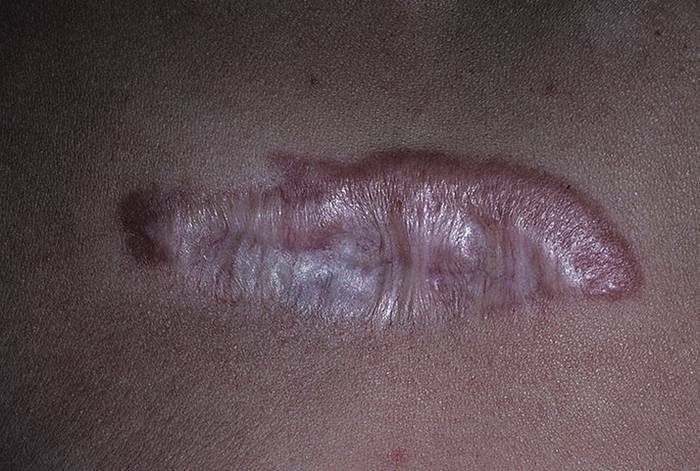The author of the article is Chuklina Olga Petrovna, general practitioner, therapist. Work experience since 2003.
Keloid scars are one type of scarring. There are also scars of the following types:
- normotrophic - scar tissue is at the same level with the surrounding skin;
- atrophic - scar tissue is located below the level of the surrounding skin;
- hypertrophic - the scar tissue rises above the level of the surrounding tissues, but unlike keloid scars, they do not grow and correspond to the size of the damage.
With the formation of a keloid scar, it spreads outside the damaged tissues.
A keloid scar has the following features:
- a clear border of scar tissue;
- the growth of scar tissue continues for a long time;
- look like growths of various shapes, unaesthetic appearance;
- education rises above intact skin;
- appear more often on the auricles, face, neck, upper chest;
- most often, the formation has a bluish color.
The patient in the place of the keloid scar may have a slight burning sensation, itching.

Photo: site of the Department of Dermatovenereology Tomsk Military Medical Institute
Reasons for education
Until now, the exact cause of the development of keloid scars has not been clarified.
In most cases, a keloid scar appears after:
- skin burns;
- carrying out surgical interventions;
- skin injuries;
- insect bites;
- piercing;
- tattooing.
It is believed that the following factors play an important role in the development of a keloid scar:
- changes in the immune system;
- changes in hormonal levels;
- inflammation during the healing process of the skin;
- genetic predisposition.
But what exactly changes are not known, there are only assumptions.
Keloid scars during the first five years are called young. They are brighter in color and have a smoother surface.
After 5 years, the scars are called old. They are pale in color, and their surface becomes wrinkled.
If you suspect a keloid scar, you should consult a dermatologist.
Keloid scar treatment
If a keloid scar is found, you cannot self-medicate, you need to consult a dermatologist or cosmetologist.
In the presence of a keloid scar, in order to avoid increased growth of scar tissue, it is prohibited:
- frequent visits to baths, saunas;
- prolonged exposure to ultraviolet radiation (sunbathing on the beach, solarium);
- scar massage;
- moxibustion of the scar by various means of traditional medicine.
There are currently no treatments that guarantee a complete cure without the risk of recurrence.
Consider the main methods of treating keloid scars at the present time.
Pressure treatment
- for this, a tight bandage is applied to the area of keloid formation, to create a mechanical obstacle to the growth of the scar. But it is necessary to wear the bandage for a long time, about 1 year. It is allowed to remove the bandage for 30 minutes a day. This method works for scars not older than one year.
Laser resurfacing of scar tissue
- allows you to make scar tissue less bright and equalize the keloid area with the level of healthy skin. Plus, it is considered that in this method the surrounding healthy tissues are not injured. The downside is that after this type of treatment, new areas of keloid tissue often appear.
Cryotherapy treatment is used for young keloid scars
- pathological tissues are frozen and damaged. The downside is that only young scars can be treated, and after treatment there is a darkening of the skin at the site of exposure.
The introduction of steroids into the keloid tissue
- procedures are carried out once a month. The duration is determined by the volume of the scar. The size and surface of the scar is significantly reduced under the influence of steroids. The downside is the likelihood of re-growth of a keloid scar.
Treatment with silicone plates
- is more of a preventive measure. Silicone plates should be applied immediately after the initial healing of the wound surface. The treatment lasts from several months to one and a half years.
Important! Applying any creams for keloid scars does not have any therapeutic effect.
Surgical removal of keloid scars
Surgical treatment is carried out in exceptional cases, when the size of the keloid formation is significant, or when other methods of treatment are ineffective.
The disadvantage of this type of treatment is that after removal of the scar, the re-formation of keloid tissues may develop. In this case, the repeated scar will be much larger. To prevent this, after surgical treatment, conservative treatment is carried out.
Most often, in the treatment of keloid scars, several methods of influencing the scar tissue are used to achieve a complete cure. Only a specialist can select the required type and duration of treatment.

